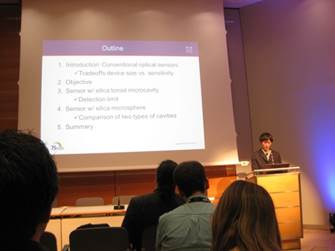CLEO-Europe2013 Jiro Nishimura
Research
CLEO/EUROPE2013@MUNICH, GERMANY Conference Report
Jiro Nishimura, 1st year master's student

Summary ]
I gave an oral presentation at CLEO/EUROPE2013 held in Munich, Germany from May 12 to 16. I have visited Germany once in the past as a traveler, and I was reminded again of its safety and delicious beer. Most of the participants at the conference communicated with people from other countries in English as a matter of course, and there were almost no people like me whose English was poor. This is a common practice in the world, but I think it was a valuable experience that is hard to experience in Japan.
This oral presentation was entitled "Study on detection of contamination of pure water using silica microsphere". This is an additional experiment to the one of last year's graduation research. The content was to evaluate the ion content in ultrapure water using two WGM resonators, a silica microsphere resonator and a silica toroid resonator. Although this was my first international conference, I was able to give my presentation as I had practiced without much nervousness because I had practiced a lot.
Research Trend Survey
(CL 6.6 TUE) J. D. Swaim et al, "Detection of Plasmonic Nanoparticles Using Whispering Gallery Mode Resonators"
This is the only sensing using a WGM resonator among those I attended this time, and gold nanorods are detected by a toroidal resonator. In this experiment, the signal is amplified by plasmon resonance using metallic nanorods, and the 10 nm nanorods were successfully detected even though the Q value was not very high (Q=6×105).
(CL 6.5 TUE) R. M. Vazquez et al, "Optical Manipulation of Single Cells in Femtosecond Laser Fabricated Lab-on-chip"
This is a study of optofluidics that combines optical tweezers and microfluidics technologies on a single substrate. Trapped cells are deformed by the laser beam and function as an optical stretcher. This is expected to be useful for cell characterization. He also studied cell sorters that classify cells. Of the two types of cells flowing from one channel, only one type fluoresces by the FWG (laser in the front), and only when it fluoresces, the SWG (laser in the back) is activated and the irradiated particles move into the other channel due to the pressure of the light. This allows the non-fluorescent particles to pass through without being detected, while the fluorescent particles move to the other channel, making it possible to classify the cell type.
(CH 3.2 WED) V. Melissinaki et al, "Fabry-Perot Vapor Microsensor onto Fibre Endface Fabricated by Multiphoton Polymerization Technique"
This paper describes the fabrication of a resonator and gas sensing. The resonator consists of four diconium silicon pillars attached to the end face of a single-mode optical fiber and a diconium silicon film attached on top of the pillars. An air gap is formed between the end face of the fiber and the silicon film, where the light is confined. In this study, 1-propanol and ethanol were used as the sensing targets, and measurements were made at different concentrations. Experiments revealed that the amount of shift tends to increase with increasing concentration, and that the amount of shift differs depending on the type of sample. FFPC is a well-known resonator using fibers, and this was the first time for me to see a structure like this one, so I felt it was new to me.
- Categories
- 国際会議報告


